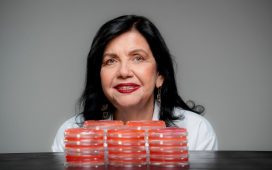Two shattering events played a critical role in British scientists’ efforts to develop technology that could transform the treatment of people who suffer traumatic injuries in wars or disasters.
The first was the blast that devastated Beirut on 4 August 2020, when a vast store of ammonium nitrate exploded in the city, killing more than 200 people and injuring 7,000. The second was Russia’s invasion of Ukraine, which has left hundreds of thousands of casualties have been inflicted since war erupted there in February 2022.
“Both the Beirut blast and the battles in Ukraine have caused thousands of dreadful extremity wounds and crush injuries in people who would lose legs and arms without urgent medical technological intervention,” said Anthony Bull, a professor of musculoskeletal mechanics at Imperial College London.
“In the past, providing that costly, complex intervention – during conflict or in the wake of natural catastrophes – has been a major problem, however.”
Prof Bull and his colleague Dr Mehdi Saeidi began a collaboration in 2016 that aimed to take a radical new approach to the problem – by finding simple ways of making complex medical devices to help those with catastrophic injuries caused by natural disasters or warfare. Instead of relying on devices flown in from developed nations, toolkits and manuals could be developed and distributed to local people so they could make their own devices in garages or factories using conventional equipment.
“We concentrated on devices known as external fixators,” Saeidi told the Observer. “These are used when a gunshot or a mine explosion or a collapsed building severs a person’s leg or arm bones. By holding pieces of shattered bone together, the injured person’s deep flesh wounds get a chance to recover and their limbs can be saved.
“Crucially, this is not done by inserting a metal rod into a limb as this could trigger serious infections. Instead, it is held outside and is attached to the bone through pins that are pushed through a person’s arm or leg.”
However, external fixators are complex and expensive. A single device can cost more than £2,000 and in conflict zones they are difficult to access. Sometimes homemade fixators are made but they often lead to serious complications.
To get round this problem, Bull and Saeidi launched their project along with colleagues at Imperial and other international institutions, with funding from the National Institute for Health and Care Research and the Engineering and Physical Sciences Research Council.
“We designed simple ways to make external fixators and tested them in Sri Lanka,” said Bull. “It was looking good. Then the Beirut explosion happened and there was an immediate call for hundreds of fixators to be sent there. We were not ready to help at this stage. Fortunately, other countries were able to step in and eventually send supplies. Nevertheless, it hit home that our initial idea had been the right one.”
Since then, Bull and Saeidi have developed sets of instructions that can be used to manufacture fixators with limited skills and resources. “All that is needed is a supply of aluminium and some stainless steel rods,” said Saeidi. “It is very straightforward.”
after newsletter promotion
The value of this work was revealed in February 2022. After Russian troops poured across the border into Ukraine, hundreds of people suffered catastrophic injuries and faced losing limbs without fixators to save their arms and legs.
“We got an urgent call from local doctors who were desperate for help and we were able to point them to our website, which had instructions on how to make fixators,” said Bull. “A couple of days later, a workshop in eastern Poland sent us a photo of a fixator they had just made from our instruction kit. In the first few days of the war, 150 of them were deployed and will have helped prevent injured people from losing legs or arms.”
Since then, Saeidi has created a tool kit for making fixators and these are being tested in Kenya and Rwanda with the aim of perfecting a technology that is ready for use anywhere in the wake of earthquakes or wars.
“When you get events like Beirut or Ukraine you get a sudden surge in terrible injuries,” said Bull. “We need simple ways to help doctors in these circumstances and that is what our fixator kits should do.”











